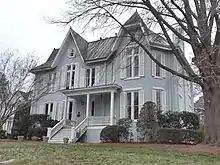Fisher Park Historic District | |
 Fisher Park Neighborhood, August 2006 | |
  | |
| Location | Roughly bounded by Fisher and Bessemer Aves. and Wharton and Church Sts.; 507 N. Church St., Greensboro, North Carolina |
|---|---|
| Coordinates | 36°04′59″N 79°47′26″W / 36.08306°N 79.79056°W |
| Area | 142 acres (57 ha) |
| Built | 1905 |
| Architect | Multiple |
| Architectural style | Bungalow/craftsman, Gothic, Foursquare, Queen Anne, Colonial Revival |
| MPS | Greensboro MPS |
| NRHP reference No. | 91002006 (original) 96000963[1] (increase) |
| Significant dates | |
| Added to NRHP | January 22, 1992 |
| Boundary increase | September 12, 1996 |
Fisher Park Historic District is a national historic district in the Fisher Park neighborhood, Greensboro, Guilford County, North Carolina. The district encompasses 541 contributing buildings, 2 contributing sites, and 44 contributing structures in a predominantly residential section of Greensboro. The houses were largely built between the 1900s and 1930s and include notable examples of Queen Anne, Colonial Revival, Gothic Revival, American Foursquare, and Bungalow / American Craftsman-style architecture. Located in the district are the separately listed Dixon-Leftwich-Murphy House, John Marion Galloway House, Julian Price House, and Latham-Baker House. Other notable buildings include the First Presbyterian Church (1928), Holy Trinity Episcopal Church (1922), Gant-McAlister House (c. 1910–15), and A.J. Schlosser House (c. 1922).[2][3]
It was listed on the National Register of Historic Places in 1992, with a boundary increase in 1996.[1]
References
- 1 2 "National Register Information System". National Register of Historic Places. National Park Service. July 9, 2010.
- ↑ Marvin A. Brown (December 1992). "Fisher Park Historic District" (pdf). National Register of Historic Places – Nomination and Inventory. North Carolina State Historic Preservation Office. Retrieved November 1, 2014.
- ↑ Jo Ramsay Leimenstoll (April 1996). "Fisher Park Historic District (Boundary Increase)" (pdf). National Register of Historic Places – Nomination and Inventory. North Carolina State Historic Preservation Office. Retrieved November 1, 2014.


